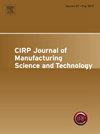基于迁移学习和突变理论的切屑流角突变平衡面实验建模
IF 4.6
2区 工程技术
Q2 ENGINEERING, MANUFACTURING
CIRP Journal of Manufacturing Science and Technology
Pub Date : 2025-03-18
DOI:10.1016/j.cirpj.2025.03.002
引用次数: 0
摘要
用突变理论提供的单一方法难以准确预测临界切割深度和切屑流动角。为解决这一问题,提出了一种迁移学习与突变理论相结合的突变现象实验建模方法。该方法成功地应用于CFA突变的平衡面建模。首先,将突变理论提供的尖点突变正则平衡面离散为两条路径(微分为d),得到一系列正则平衡点坐标(u,v,x);然后,构造并训练了具有3个输入节点(u,v,d)和1个输出节点(x)的模拟典型平衡曲面的神经网络模型。接下来,采用迁移学习的方法对模型进行冻结,并在模型前后添加全连通层,实现实际参数到规范参数所需的微分同构。前层有3个节点(f,ap,d '),后层有1个节点(φ)。最后,利用实验数据对附加层模型进行微调,得到CFA突变的实际平衡面模拟模型。试验结果表明,所建立的模型对CFA和临界切割深度的预测精度优于其他方法建立的模型。本文章由计算机程序翻译,如有差异,请以英文原文为准。
Experimental modeling of equilibrium surface for chip flow angle catastrophe based on transfer learning and catastrophe theory
It is difficult to accurately predict the critical depth of cut and the chip flow angle (CFA) using a single method provided by catastrophe theory. To solve this problem, an experimental modeling method for catastrophe phenomena combining transfer learning and catastrophe theory is proposed. This method is successfully used for the modeling of the equilibrium surface of the CFA catastrophe. First, the canonical equilibrium surface of cusp catastrophe provided by catastrophe theory is discretized in two paths (differentiated by ), and a series of canonical equilibrium point coordinates () are obtained. Then, a neural network model simulating the canonical equilibrium surface with three input nodes () and one output node () is constructed and trained. Next, the transfer learning method is applied to freeze the model and add fully connected layers before and after it to realize the required diffeomorphism from the actual parameters to the canonical parameters. The front layers have 3 nodes () and the rear layers have 1 node (). Finally, the model with the additional layers is fine-tuned using experimental data to obtain the actual equilibrium surface simulation model for the CFA catastrophe. The test results show that the prediction accuracies of the constructed model regarding the CFA and the critical depth of cut are better than those of the models established by other methods.
求助全文
通过发布文献求助,成功后即可免费获取论文全文。
去求助
来源期刊

CIRP Journal of Manufacturing Science and Technology
Engineering-Industrial and Manufacturing Engineering
CiteScore
9.10
自引率
6.20%
发文量
166
审稿时长
63 days
期刊介绍:
The CIRP Journal of Manufacturing Science and Technology (CIRP-JMST) publishes fundamental papers on manufacturing processes, production equipment and automation, product design, manufacturing systems and production organisations up to the level of the production networks, including all the related technical, human and economic factors. Preference is given to contributions describing research results whose feasibility has been demonstrated either in a laboratory or in the industrial praxis. Case studies and review papers on specific issues in manufacturing science and technology are equally encouraged.
 求助内容:
求助内容: 应助结果提醒方式:
应助结果提醒方式:


